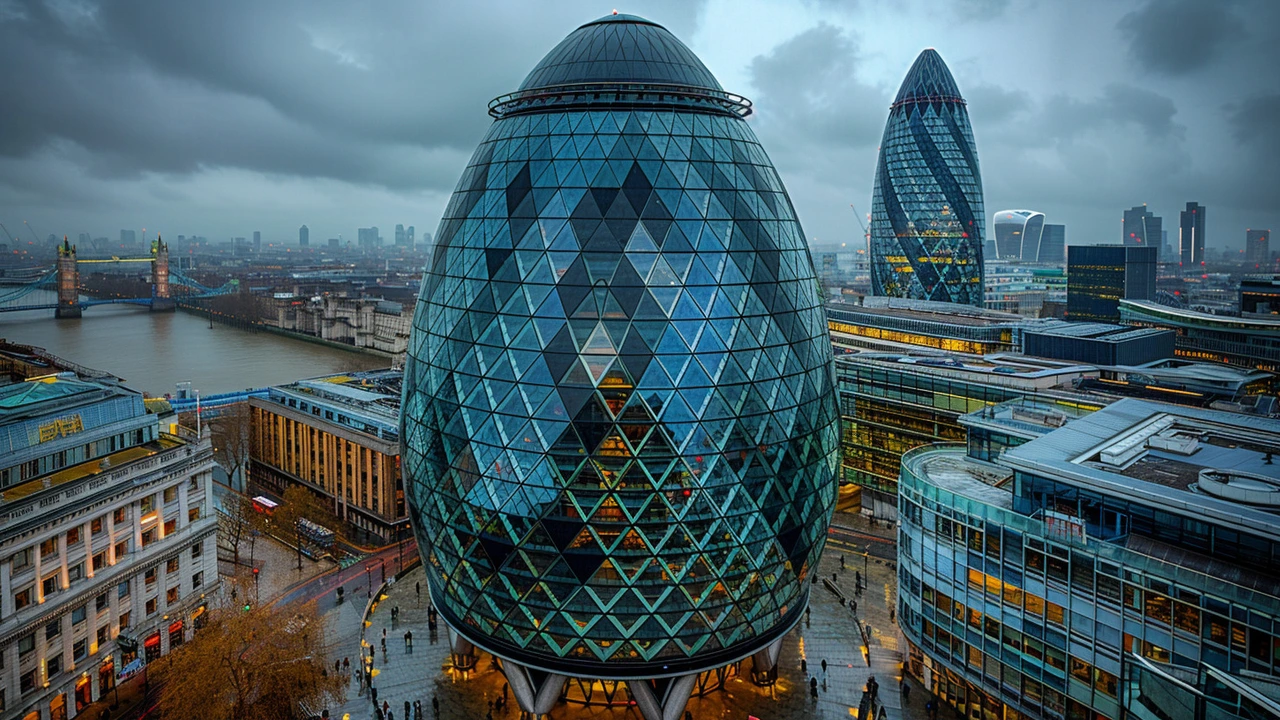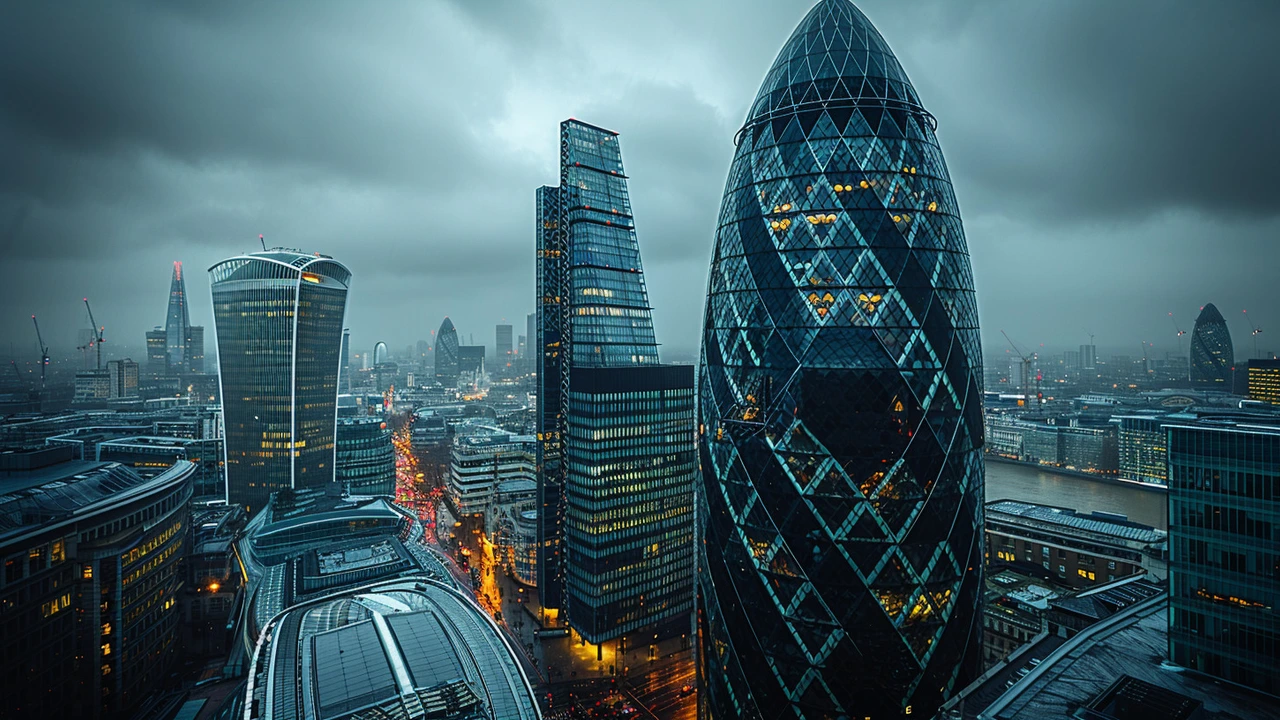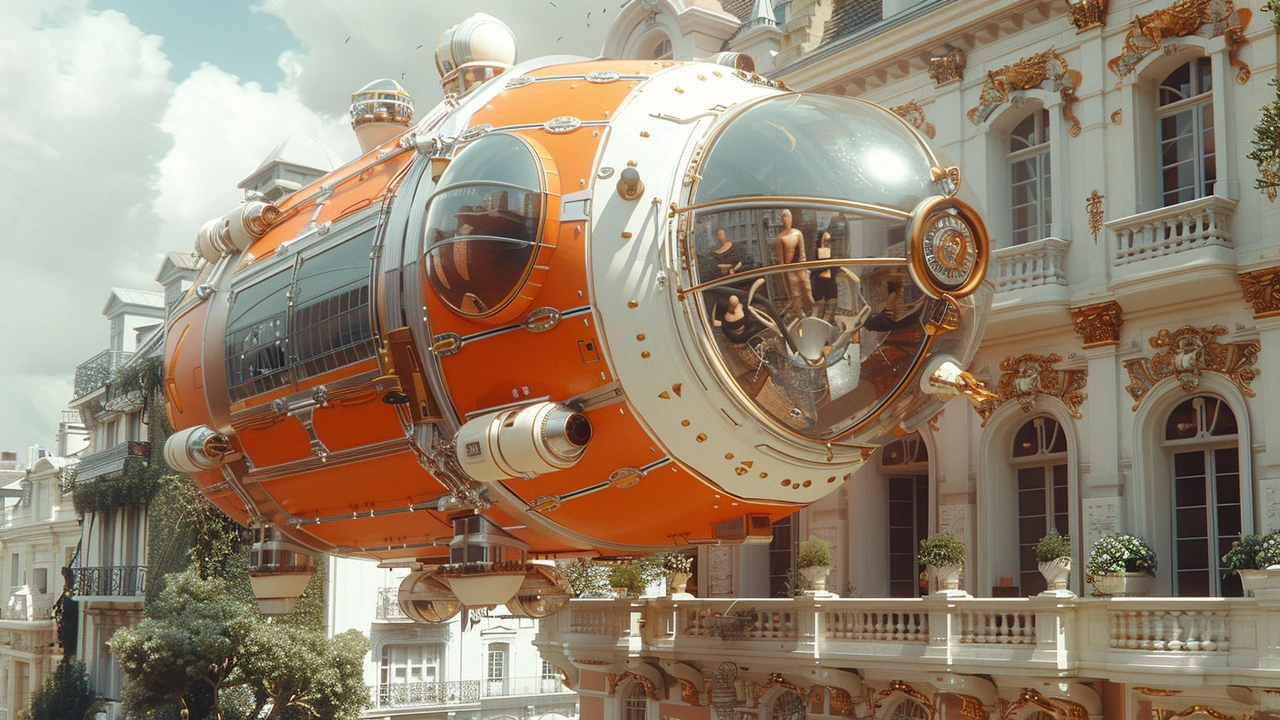Exploring the Vibrant World of Expressionist Architecture
 Jun, 18 2024
Jun, 18 2024
Expressionist architecture is a strikingly unique style that emerged in the early 20th century. It is known for its dramatic forms, bold colors, and emotional intensity, which reflect the avant-garde movement of the time.
This architectural approach sought to break away from the traditional norms and embrace creativity and innovation. Buildings designed in the expressionist style often feature curved and organic shapes, asymmetry, and dynamic forms that evoke movement and emotion.
The roots of this style can be traced back to Europe, particularly in Germany and the Netherlands, where architects were inspired by the works of expressionist artists and the cultural movements of the era.
- Defining Expressionist Architecture
- Historical Context and Origins
- Key Characteristics and Features
- Noteworthy Buildings and Structures
- Influential Architects and Their Works
- Tips for Identifying Expressionist Architecture
Defining Expressionist Architecture
Expressionist architecture is a distinctive movement that marries imagination and structure. This style broke from the rigidity of traditional designs and became a symbol of innovation and artistic freedom in the early 20th century. Architects in this movement wanted to express deeper emotional and spiritual experiences through their building designs. The core of expressionist architecture is about celebrating the human spirit and the natural world, often drawing inspiration from natural forms, fluid lines, and organic shapes.
The influence of expressionist architecture can be traced back to the avant-garde art movements, including Expressionism in painting and literature. It’s fascinating how architects aimed to translate the intensity of these art forms into the physical realm of buildings. The results were often structures that appear almost sculptural, often characterized by their dynamic shapes and vivid use of color and texture. They aspired to transcend the mundane, pushing the boundaries of their medium.
One of the most iconic examples of this style is the Einstein Tower in Potsdam, Germany, designed by Erich Mendelsohn. This biomorphic structure was conceived to house a solar observatory and it embodies the fantastical and futuristic elements of expressionist design. Mendelsohn used reinforced concrete to create sweeping, fluid forms that look almost otherworldly.
Expressionist architects didn’t just limit themselves to external aesthetics. They often employed innovative construction techniques and materials to realize their visionary designs. Traditional building methods couldn't always accommodate their ambitious forms, so they had to experiment and adapt. This spurred advancements in building technology, which have influenced modern architecture even beyond the expressionist period.
It is important to note that expressionist architecture wasn't confined to any particular region or country. While it had significant roots in Germany and the Netherlands, its principles spread across Europe and beyond. The growth of this style was partly fueled by the cultural and political upheavals of the early 20th century. These tumultuous times called for new ways of thinking and living, which was mirrored in the daring and unconventional buildings of the expressionist movement.
Many expressionist buildings also served as a canvas for other forms of modernist art. They often displayed artworks within or as part of their structure, creating a harmonious blend of different creative disciplines. This holistic approach to design was revolutionary for its time. It reinforced the idea that architecture could be a comprehensive art form, embracing various artistic contributions.
A key aspect of expressionist architecture is its emotional impact. These buildings are designed not just to be seen but to be felt. Their unusual shapes and dramatic structures often evoke a strong emotional response from the viewer, making them stand out in the architectural landscape. They challenge perceptions and invite us to see the world in a different light, reminding us of the endless possibilities of human creativity.
In a quote by Erich Mendelsohn, he said, "My architecture can only be understood by those who feel it is music." This powerful statement captures the essence of expressionist architecture, where every curve and line is akin to a note in a symphony, creating a harmonious and emotive spatial experience.
Historical Context and Origins
Expressionist architecture has its roots deeply embedded in the early 20th century, emerging predominantly in Germany and the Netherlands. This period was marked by significant social, political, and technological changes which influenced the way architects conceived their designs. During the early 1900s, the aftermath of World War I led to a collective desire to break free from traditional forms and embrace new, more emotionally resonant designs. The need for societal reinvention and the quest for identity in a post-war world provided a fertile ground for expressionist ideas to flourish.
The founding moment of expressionist architecture is often traced back to the work of the German architectural group, Der Ring. Architects like Erich Mendelsohn and Bruno Taut spearheaded this group, pushing the boundaries of what buildings could look like and symbolically represent. Their works often emphasized organic forms, innovative use of materials, and a deep connection with the emotional and spiritual aspects of human life. Bruno Taut's Glass Pavilion, for instance, presented at the 1914 Werkbund Exhibition, remains a quintessential example of early expressionist architecture where the use of glass and light was intended to evoke a transcendental experience.
The profound influence of expressionist art on architecture cannot be overstated. Artists like Wassily Kandinsky and Franz Marc, who were part of the expressionist art movement, particularly inspired architects. The emotional intensity, bold colors, and abstract forms of their artworks found architectural parallels in buildings designed to elicit strong emotional responses. This blending of visual art and architecture marked a significant departure from the rigid, functionalist styles that had dominated the earlier architectural ethos.
Expressionist architecture was also significantly shaped by advancements in technology and materials. The introduction of reinforced concrete, steel, and glass allowed architects to experiment with new forms and structures that were previously impossible. These technological developments enabled the construction of buildings like Erich Mendelsohn's Einstein Tower, completed in 1921, which stands as a striking example of expressionist architecture with its flowing, organic shape and futuristic design.
The socio-political environment of the time further fueled the rise of expressionist architecture. The Bauhaus movement, though primarily associated with modernist architecture, also had a considerable influence on expressionist architects. There was a shared belief in the potential of design to shape human experience and social change. While Bauhaus focused more on function and minimalism, expressionist architecture embraced the emotional and spiritual dimensions of human life, often manifesting in theatrical and dramatic forms.
In summary, the historical context and origins of expressionist architecture are intricately linked with the upheavals of the early 20th century. The movement's desire to break free from tradition, combined with artistic influences and technological advancements, gave rise to a unique architectural style. Its emphasis on emotional and spiritual resonance continues to inspire architects and designers today, reminding us of the powerful connection between the built environment and human experience.

Key Characteristics and Features
Expressionist architecture stands out for its strong emphasis on emotional experience and inventive forms. One of the core characteristics of this style is its ability to convey feelings through built structures, creating spaces that resonate on a deeper level with their occupants. Buildings often deviate from traditional symmetrical forms, embracing asymmetry and fluidity of design.
These structures frequently utilize unusual shapes, curves, and angles, giving them a dynamic and organic appearance. Materials play a significant role in expressionist architecture, with architects favoring those that can be molded or sculpted into unconventional forms. Think glass, steel, and concrete used in ways that highlight their inherent plasticity.
Another defining feature is the use of bold colors and textures. The exteriors might display vibrant, eye-catching hues or intricate patterns, enhancing the visual impact. Windows are often large and irregularly shaped, allowing natural light to flood the interiors in unexpected ways, creating captivating light and shadow play.
Expressionist architects also draw inspiration from natural elements and landscapes, mimicking the flowing lines of rivers, ruggedness of mountains, or whimsical shapes of plants and animals. This connection to nature not only enriches the aesthetic appeal but also imbues the structures with a sense of harmony and balance despite their bold, avant-garde appearance.
An excellent example of this style is the Einstein Tower in Potsdam, Germany designed by Erich Mendelsohn. Completed in 1921, this observatory is notable for its undulating, wave-like form and use of reinforced concrete, which allowed Mendelsohn to sculpt the building into its distinctive organic shape.
"Architecture is the will of an epoch translated into space." - Ludwig Mies van der Rohe
The interior spaces in expressionist buildings are just as striking as their exteriors. They often feature open floor plans, with spaces flowing seamlessly from one to another. This fluidity creates a sense of movement and continuity within the structure, further enhancing the emotional and sensory experience for those within.
When it comes to furnishings and decor, expressionist architecture favors pieces that reflect the same sense of creativity and individuality. Furniture might be custom-designed to fit the unique shapes and contours of the space, incorporating artistic elements that echo the overall theme of the building.
In terms of impact, expressionist architecture challenged the conventions of its time, paving the way for future generations to explore new possibilities in architectural design. Its emphasis on emotion, nature, and innovation continues to inspire architects and designers today, encouraging them to think outside the box and create spaces that are not just functional, but also deeply resonant on an emotional level.
Noteworthy Buildings and Structures
Expressionist architecture has given birth to some of the most remarkable buildings and structures that continue to astound and inspire. One of the quintessential examples of this style is the Einstein Tower, designed by Erich Mendelsohn. Constructed between 1919 and 1921 in Potsdam, Germany, the Einstein Tower served as an astrophysical laboratory. Its bold and dynamic lines, along with its fluid forms, were a radical departure from traditional architecture, embodying the experimentation and creativity of the expressionist movement. The structure almost appears to be sculpted rather than constructed, which gives it an otherworldly presence.
Another iconic structure is the Shell House in Berlin, completed in 1932 by Emil Fahrenkamp. Its undulating exterior, composed of a series of curves that resemble a wave, makes it one of the most distinctive examples of expressionist design. This building's rhythmic form evokes movement, creating a visual representation of the dynamic nature of modern urban life. The use of lightweight materials and innovative construction techniques was also a standout feature, showcasing how expressionist architects were not afraid to push technological boundaries.
Moving to the post-war period, another highlight is the Sydney Opera House, conceived by Danish architect Jørn Utzon and completed in 1973. While not purely expressionist, its unique shell-like design and dramatic forms are deeply influenced by expressionist principles. The building quickly became one of the most recognizable landmarks in the world. Utzon's ability to blend fluidity with functionality demonstrates the timeless appeal of expressionist ideas.
Ludwig Mies van der Rohe once remarked, “Architecture starts when you carefully put two bricks together. There it begins.” The Sydney Opera House exemplifies this sentiment, showcasing how purity of form and material can create an enduring icon.
A lesser-known yet profoundly influential example is the The Chilehaus in Hamburg, Germany, designed by Fritz Höger and completed in 1924. This office building's sharp, angular facade, which juts out like the prow of a ship, is a testament to the dramatic aesthetics of expressionist architecture. The interplay of light and shadow across its glazed brick surface adds to its striking visual impact, making it a pioneer among its contemporaries.
Another remarkable example is the Goetheanum in Dornach, Switzerland. Designed by Rudolf Steiner and completed in the early 1920s, this building serves as the headquarters for the Anthroposophical Society. Its organic shapes and extensive use of glass create a mystical atmosphere, emphasizing the holistic and spiritual aspects of expressionism. The Goetheanum stands as a prime example of how architectural design can transcend functionality to engage with deeper philosophical concepts.
As these examples illustrate, expressionist architecture is not confined to a single form or material. Its diversity of styles and approaches allows it to continually evolve, influencing contemporary architects and designers. When exploring an urban landscape, seek out unique shapes, bold colors, and unconventional materials. These are often telltale signs of expressionist influences, offering a fascinating glimpse into the creativity and innovation that define this extraordinary architectural style.

Influential Architects and Their Works
When talking about expressionist architecture, it's essential to honor the visionaries who have shaped this remarkable style. These architects pushed the boundaries of conventional design, creating masterpieces that still captivate people today. Among these influential figures are Erich Mendelsohn, Bruno Taut, and Hans Poelzig, each of whom left an indelible mark on the architectural landscape.
Erich Mendelsohn is one of the most celebrated architects of the expressionist movement. His works are characterized by their organic forms and dynamic sense of movement. One of his most famous projects, the Einstein Tower in Potsdam, Germany, is an iconic example of his style. The tower, built in the early 1920s, served as an astronomical observatory and was revolutionary due to its futuristic appearance and innovative use of reinforced concrete.
Another key figure, Bruno Taut, is often remembered for his colorful approach to architecture. He was a proponent of the German Werkbund, which aimed to bring art and industry closer together. One of his notable works is the Glass Pavilion, built for the 1914 Werkbund Exhibition in Cologne. The pavilion was a kaleidoscope of colors and lights, intended to demonstrate the beauty and potential of glass as a modern architectural material. Taut's work didn't just stop at buildings; he wrote extensively about the social and cultural roles of architecture, emphasizing its potential to inspire and uplift communities.
Finally, Hans Poelzig was another pioneering architect who contributed significantly to the expressionist style. His design of the Berlin Grosses Schauspielhaus, also known as the Great Theatre, is a testament to his innovative vision. Completed in 1919, the theater featured a cavernous interior with elaborate, almost otherworldly decor, which was intended to transport theatergoers to a different realm. Poelzig's ability to merge drama with architecture made his works stand out.
Each of these architects brought their unique perspectives to the table, creating buildings that weren't just structures but works of art. Expressionist architecture is more than just a style; it's a testament to human creativity and the desire to innovate. As such, studying these architects and their works offers valuable insights into the endless possibilities of design. The emotional impact of their designs continues to influence modern architecture, proving that their contributions transcend time.
"Architecture should speak of its time and place, but yearn for timelessness." - Frank Gehry
Understanding these influential architects and their works provides a foundation for recognizing and appreciating the expressive power inherent in this architectural style. These pioneers challenged the norms and laid the groundwork for future innovations, making expressionist architecture a crucial chapter in the history of design.
Tips for Identifying Expressionist Architecture
Identifying expressionist architecture can be a thrilling adventure, much like a treasure hunt through the urban jungle. The style is known for its flair and emotive power, making each discovery a rewarding experience. To start with, one should look for dramatic forms that break conventional design rules. These structures often incorporate swooping curves, jagged peaks, and asymmetrical façades that stand out in a sea of traditional buildings.
Expressionist buildings usually embrace organic materials and raw textures. Instead of polished surfaces, you might find rugged stone, rough concrete, or stained glass that catch the eye. A notable feature to search for is the use of vivid colors. This style doesn't shy away from bright hues and bold contrasts that can evoke different emotional responses. The use of stained glass windows, for instance, is a common trait, found in buildings like the Einsteinturm in Potsdam, Germany.
Often, these structures emphasize emotional experience over functionalism. For instance, interiors might have irregularly shaped rooms or unexpected element placements, designed to evoke a sense of wonder. Architects in this genre aim to create spaces that are as much about feeling as they are about accommodation. A helpful tip is to pay attention to the interaction between light and shadow. Expressionist structures often play with light in unique ways, using angled surfaces or textured materials to cast dynamic shadows, especially noticeable in changing daylight.
"Architecture should speak of its time and place, but yearn for timelessness." - Frank Gehry
Several iconic buildings can serve as benchmarks when identifying this style. The famous Erich Mendelsohn's Einsteinturm is a textbook example. The way it erupts from the ground with a fluid, almost mushroom-like shape is a hallmark of expressionist tendencies. Another significant reference is the Goetheanum in Switzerland, designed by Rudolf Steiner, which combines expressive, sculptural forms with intricate detailing that defies traditional design.
For those eager to delve deeper, a practical approach is to develop an eye for asymmetry. Where other architectural styles strive for balance and proportionality, expressionism thrives on irregularity and disruption. Rooflines that twist and turn, windows that protrude and recede, and facades that undulate are all clues to look out for.
Finally, understanding the historical and cultural context can enhance your ability to recognize these buildings. Expressionist architecture often emerged as a reaction against industrialization and war, seeking to reclaim a sense of humanism and artistry. Knowing the era and movements that influenced a particular building or architect can provide valuable insight and appreciation.